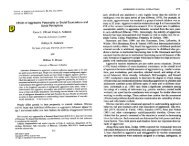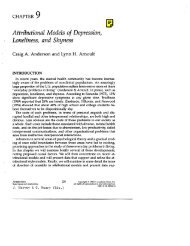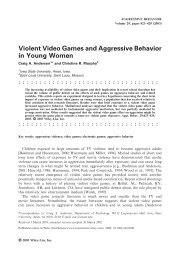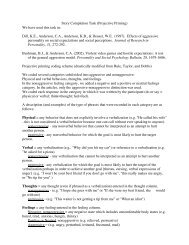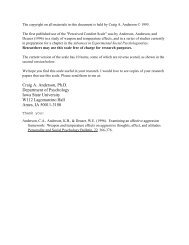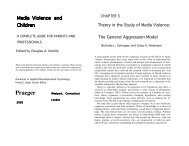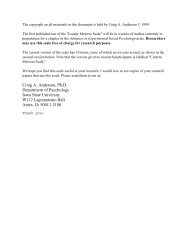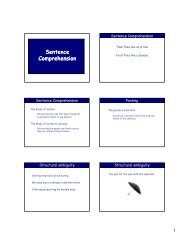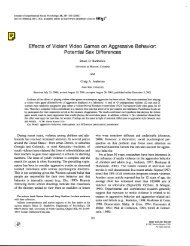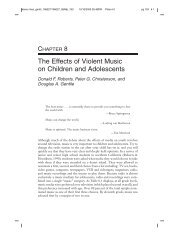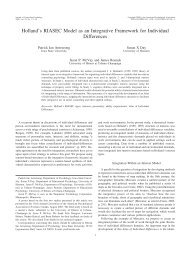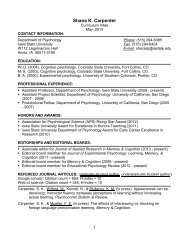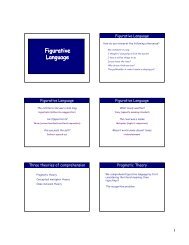Measures of attributional style
Measures of attributional style
Measures of attributional style
Create successful ePaper yourself
Turn your PDF publications into a flip-book with our unique Google optimized e-Paper software.
Attribution Styles 117<br />
global attributions for negative events tend to be<br />
more depressed. However, there are at least four<br />
problems with the ASQ. First, internal consistency<br />
for the ASQ ranges from adequate to low,<br />
especially for the locus dimension. A frequent<br />
solution is to combine the three dimensions into<br />
a single index to increase reliability, as the<br />
dimensions tend to correlate highly with one<br />
another. However, this creates a second problem<br />
one <strong>of</strong> interpretation. There are unique predictions<br />
for each <strong>attributional</strong> <strong>style</strong> dimension; using<br />
a composite score prevents valid tests <strong>of</strong> the<br />
model (Carver, 1989). Reivich (1995) advises<br />
researchers to analyse ASQ data in terms <strong>of</strong> both<br />
individual dimensions and composite scores. The<br />
third problem is also related; the ASQ does not<br />
assess the key <strong>attributional</strong> dimension <strong>of</strong> controllability.<br />
The few studies that included<br />
controllability consistently find that it is the<br />
most important <strong>attributional</strong> <strong>style</strong> dimension,<br />
whereas globality is the least important (e.g.<br />
Deuser & Anderson, 1995). The fourth problem<br />
concerns the affiliation versus achievement<br />
distinction; several <strong>of</strong> the ‘achievement’ items<br />
involve affiliative contexts. The Expanded<br />
Attributional Style Questionnaire (EASQ;<br />
Peterson & Villanova, 1988) uses an identical<br />
format to the ASQ and addresses the problem <strong>of</strong><br />
low reliability by increasing the number <strong>of</strong><br />
situations included in the measure. However,<br />
reliabilities remain modest and the other problems<br />
remain unresolved.<br />
The third and fourth versions <strong>of</strong> the<br />
Attributional Style Assessment Test (ASAT-III<br />
and ASAT-IV) provide another dimensional<br />
assessment <strong>of</strong> <strong>attributional</strong> <strong>style</strong> (Anderson &<br />
Riger, 1991). These measures use a format<br />
similar to the ASQ but they incorporate a<br />
larger number <strong>of</strong> items (20 for the ASAT-III<br />
and 36 for the ASAT-IV), include the controllability<br />
dimension, and use success and failure<br />
items that mirror each other (e.g. ‘succeeded’ vs.<br />
‘failed’ at coordinating an outing for a group <strong>of</strong><br />
people...). The interpersonal versus noninterpersonal<br />
subsets <strong>of</strong> items are more clearly differentiated<br />
than the affiliation versus achievement<br />
items <strong>of</strong> the ASQ. Internal reliabilities at the<br />
subscale level tend to be weak to modest, in<br />
the 0.5–0.6 range; collapsing across situation<br />
types (e.g. ignoring the interpersonal vs. noninterpersonal<br />
distinction) yields somewhat larger<br />
alphas. These scales have successfully predicted<br />
depression, loneliness, and shyness as well as<br />
depressive-like motivational deficits in laboratory<br />
settings. Furthermore, this body <strong>of</strong> work has<br />
demonstrated the importance <strong>of</strong> assessing <strong>attributional</strong><br />
<strong>style</strong>s separately for interpersonal and<br />
noninterpersonal situations. Finally, this work<br />
has shown substantial correlations between<br />
<strong>attributional</strong> <strong>style</strong>s for successful events and<br />
depression (and loneliness and shyness).<br />
Several other dimensional measures <strong>of</strong> <strong>attributional</strong><br />
<strong>style</strong> use the same basic approach as the<br />
ASQ and ASAT. The Balanced Attributional<br />
Style Questionnaire (BASQ; Feather &<br />
Tiggemann, 1984) uses a format similar to the<br />
ASQ but, like the ASAT, the positive and<br />
negative items mirror one another. The scales<br />
have moderate reliabilities and correlate with<br />
depression, self-esteem, and protestant work<br />
ethic. The Real Events Attributional Style<br />
Questionnaire (REASQ; Norman & Antaki,<br />
1988) requires that respondents generate the<br />
positive and negative events for which they then<br />
make attributions. This may yield a better<br />
prediction <strong>of</strong> depression, but the loss <strong>of</strong> item<br />
standardization creates other problems.<br />
Forced-Choice <strong>Measures</strong><br />
Forced-choice measures have respondents select a<br />
cause from a list <strong>of</strong> potential explanations. One<br />
benefit is that this method may more accurately<br />
mirror how people typically select a cause (i.e.<br />
without thinking about dimensions). Also, the<br />
types <strong>of</strong> causes in the list can be restricted to only<br />
those attributions <strong>of</strong> theoretical interest. Forcedchoice<br />
measures also require less time to<br />
complete.<br />
The ASAT-I and ASAT-II use this forced<br />
choice format. Respondents are provided with a<br />
number <strong>of</strong> hypothetical situations (20 for the<br />
ASAT-I and 36 for the ASAT-II). On the ASAT-<br />
I, the listed types <strong>of</strong> causes are strategy, ability,<br />
effort, personality traits, mood, and circumstances.<br />
ASAT-II includes only strategy, effort,<br />
and ability causes. The number <strong>of</strong> times a<br />
particular cause is selected is summed to create a<br />
measure <strong>of</strong> <strong>attributional</strong> <strong>style</strong> for that dimension.<br />
Kuder–Richardson (K-R 20) reliabilities for<br />
the subscales tend to be in the low to moderate<br />
range. Correlations with loneliness and depression<br />
have established the validity <strong>of</strong> these<br />
[8.8.2002–12:29pm] [1–128] [Page No. 117] FIRST PROOFS {Books}Ballesteros/Ballesteros-A.3d Paper: Ballesteros-A Keyword



